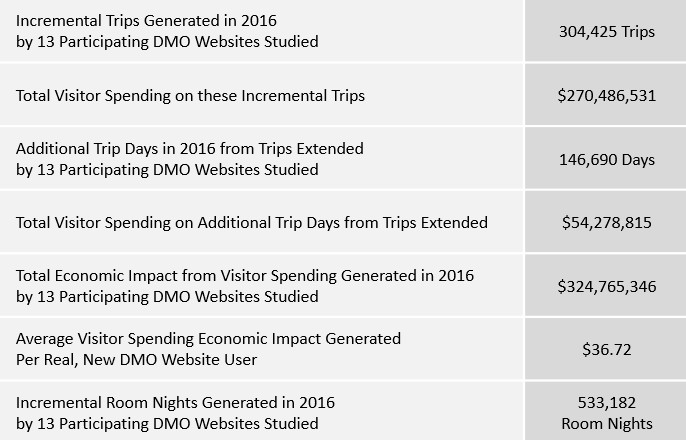DMO Websites and the 3.4% Rule
Did you know that, on average, 3.4 percent of DMO website users are converted by these sites from an undecided potential traveler to an actual visitor? Our recent landmark study of 13 Western U.S. DMO websites revealed that while this conversion factor may seem modest, the resulting economic impact to the DMOs’ communities is very significant. In fact, for every real, new website user of the 13 DMO websites we studied, $37 in new visitor spending was injected into their localities. Read on to learn more!
While the modern DMO must tackle a dizzying array of online marketing objectives, inspiring undecided website users to visit the destination is quite possibly their most important online objective. The reason for this is straightforward. Generating so-called “incremental visits” is the single greatest source of return on investment created by these organizations’ digital expenditures. In partnership with the DMA West Education & Research Foundation, our team recently completed a fascinating comprehensive study of DMO websites, which benchmarks and explains the reach and impact of these websites.
An executive summary of this exciting research approach pioneered by Destination Analysts is now available. This year-long project analyzed visitor traffic to the websites of 13 DMOs in the Western United States. A primary objective of this project was to estimate the direct visitor spending these websites produce for their respective communities. Essentially, we sought to estimate the total amount of direct visitor spending in-market that was generated by and attributable to the DMO website. Alternatively, it’s the amount of visitor spending in the destination that would not have occurred in the absence of the website.
The results are compelling. There is no doubt that DMO websites are invaluable marketing assets and significant generators of economic impact for their communities. Following are the key economic impact metrics that emerged from the study. These findings are based on 8,845,291 real, new website users of all 13 participating DMO websites between January 1, 2016 and January 1, 2017.
- Incremental trips generated by the thirteen participating DMO websites: For 8,845,291 real, new users of the 13 DMO websites during the year, an estimated 304,425 incremental trips were generated for the respective destinations. An incremental trip is one in which the user decided to visit the destination based on their experience with the DMO website, and thus any visitor spending in the destination on these trips can be counted as part of the website’s economic impact. The average incremental trip lasted approximately three days, with a reported in-market spending of $306 per day. These incremental trips are estimated to have generated $270,486,531 in new visitor spending in these destinations.
- Additional days on trips extended generated by the 13 participating DMO websites studied: A second way DMO websites can generate economic value is by inspiring visitors to extend their already planned visits. The research conducted shows that for 8,845,291 real, new users of these thirteen sites, 146,690 new visitor days were generated for the respective destinations. This is estimated to have resulted in an additional $54,278,815 in incremental visitor spending in these destinations.
- Total estimated economic impact: The two components discussed above (spending on incremental trips and additional days in-market) comprise the program’s economic impact as defined in this study. It is estimated that for 8,845,291 real, new users of the thirteen participating DMO websites, $324,765,346 in total economic impact was generated for the respective destinations. Based on these findings, it is estimated that each real, new user to a DMO website ultimately generates $36.72 in visitor spending in the destination the site is marketing. Given the total collective budgets of these thirteen DMOs, these websites brought an average return of approximately four-to-one for their respective destinations.
- Incremental hotel room nights generated by the 13 participating DMO websites studied: Given the number and length of incremental and extended trips generated by the DMO websites, and the proportion of these visitors reporting that they stayed in a hotel in the destination, it is estimated that for 8,845,291 real, new users of the thirteen websites during the 12-month period of study, 533,182 incremental room nights were generated in the respective destinations’ hotels.
Of course, the results of individual DMO websites varied greatly—showing that there is no substitute for conducting your own research. Still, the overall story is compelling. The DMO’s influence on local economic performance through inspiring travel to their destinations is inarguably significant.
Click here to read the complete executive summary of findings.



